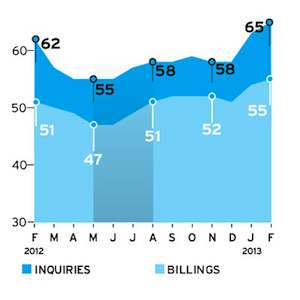The announcement that the Architecture Billings Index (ABI), a reliable measure of the industry’s health, had clocked in at a post-recession high of 54.9 in February has many designers feeling that the worst of the downturn is behind them, even if they have made that claim before. The ABI has now surpassed 50 for seven straight months, its best performance since the official 2009 end of the recession. Still, hiring continues to be soft, as firms refocus their energies.
 |
| Image © Architectural Record ABI Index |
“We’re still hunkered down, trying to be very efficient at everything we do,” says Steve Ruth, a founding principal at Perkowitz + Ruth. The 34-year-old firm, based in Long Beach, California, focused on retail projects for longtime clients like Kroger and Walmart before the economy turned, forcing it to let go more than half its staff between 2008 and 2012, with much of that in the last year. It has 160 employees today and doesn’t plan to start hiring anytime soon.
Overall, hiring gains have been incremental. In January, architecture firms employed 156,500 people, according to the U.S. Bureau of Labor Statistics, and that number has been steady for the past three years. In January 2012, there were 152,300; in January 2011, 154,200. By contrast, in January 2007, when the economy was in better shape, there were 210,900 employees, the agency says.
But hiring, which usually trails economic improvement, is imminent, notes Tom Ward, a principal of Resource Staffing Consultants,
a recruiting firm, who says he’s busier now than at any time in the last seven years: “Firms are starting to believe we’re in a recovery, so they’re investing in things they never thought they would invest in again.”
There have been hopeful signs before. Since plunging to a low of 34.4 in January 2009, the ABI, which is based on surveys of American Institute of Architects (AIA) members, has cracked the key 50 mark several times—a score above 50 indicates an increase in billings—before falling again. “We’re cautiously optimistic,” says Bill Wilson, the founding principal of Wilson Architects. In the past year his Boston firm has hired 15 people, boosting his staff to 55. The office, which focuses almost exclusively on college projects, says recent commissions at Boston University, Northeastern University, and Vanderbilt University fueled the expansion.
Even the behemoth firm Stantec faced leaner times. “When you come out of a trough, you want to highly utilize your employees, which we did for a long time,” says Roger Swanson. He heads Stantec’s West Coast design practice and says the Canadian firm, which has about 150 offices in the U.S., will also hire this year, after beginning to add people in 2012; as work picks up, the catch-22 is that firms can only run so lean for so long.

Post a comment to this article
Report Abusive Comment